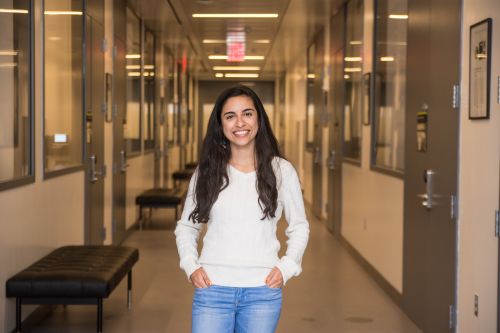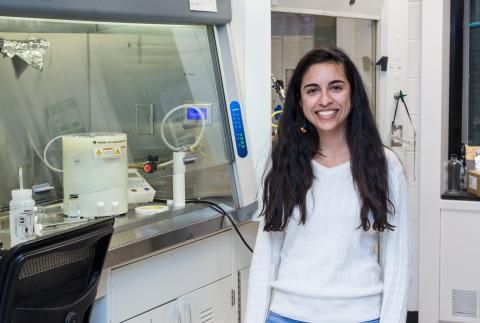
Ever since she was a little girl, Nikita Dutta has been coming up with solutions for the problems around her. When a regular knife took too long to cut her Eggo waffles, she invented a cutter that slid down around the square ridges. When her spare change was disorganized, she made a coin sorter out of a cereal box to separate her pennies and nickels. When she did not want to walk downstairs for a drink of water, she created a long straw that reached from her room to the sink.
“I always liked inventing and creating things. It combines my enjoyment for making projects with my hands and my need to make life around the house more efficient,” says the third-year PhD student in MAE.
Back then Nikita would take apart old toys and sift through the recycling to find spare parts. Today, as a materials scientist, she also finds ways to repurpose materials by changing their properties and structures to make them work in new or more efficient ways.
In sixth grade, Nikita’s career placement test predicted she would be an air condition repairperson. Discouraged, because there was no college required for that field, she looked at the list of alternative career paths and landed on physicist. It was not a subject that interested her throughout grade school, but all that changed when she started college at Yale University.
Ironically, the only reason Nikita ever signed up for intro to physics was because it was required for biology, which she thought at the time might become her major. “When I found out I could place out of intro to physics, I called my mom for advice. My parents always taught me never to take the short route to anything—that I should take everything slow and use it as an opportunity to learn more,” she said.
Her parents were right, and much to Nikita’s surprise she fell in love with physics. “I started to see how physics explains everything around you and how through math you could derive natural phenomena,” she explains. “Physics creates order for the entire world—it gives you these unifying laws that explain things seemingly disconnected. I really like when things can be packaged up neatly or follow some kind of pattern.”
In her junior year, Nikita became involved in a particle physics research project. She developed an algorithm to reconstruct muon events coincident between the Ice-Cube Neutrino Observatory and the DM-Ice 17 dark matter detector. Her goal was to reduce background noise for both experiments.

It was the first time Nikita saw herself pursuing a career in research. “Repairing implies an endpoint,” she explains. “When the job is done, the device works one way, and there is nowhere to go from there. Research, on the other hand, builds off existing science, but there is no fixed endpoint. Even after a successful study, there is somewhere new to go.”
Like the inventions Nikita made to ease childhood problems, she wanted to be involved in projects that would make people’s daily lives better. Materials science, she thought, was a nice combination of fundamental science and real-world applications that can have an impact on society.
“In any kind of engineering you need materials that behave efficiently and with the right kinds of properties. Materials science often fuels innovation in other areas. Some of my work can be used in solar energy, some in medicine for laser surgery, and some in information storage,” she says.
This is because Nikita works on processing materials that are used for optical devices. By better characterizing these materials, researchers can learn how changing their structures affects properties that make them work better. These devices, which use light to transmit information or store energy, have applications in fiber optic networks, chemical sensors, and more.
When researchers make a device there are three major phases: synthesizing the material, processing the material, and fabricating the device. Nikita works on the second part, specifically in solution processing. She tries to understand how materials change when they are dissolved in a certain type of solvent. In particular, she is looking at a class of materials called chalcogenide glasses that are very responsive to light and can be manipulated by solution processing.
“Solution processing is useful because it is very simple—you do not need high temperatures or expensive equipment. You can simply add things to the solution that change the structure of the material. It is also very flexible so it allows for a variety of deposition methods, like inkjet printing or filling a mold,” she says.
Since materials are difficult to study in a dissolved state, researchers often use reverse engineering to determine how solution processing affects final material properties. Nikita, however, is looking to gain more control over the process with a forward-thinking strategy by adding knowledge of the material structure.
“Through her hard work, Nikita has developed new characterization methods that have revealed the first-ever experimental validation of the molecular structure of this material in solution,” says Craig Arnold, PhD, Professor of Mechanical and Aerospace Engineering. “This is an initial stage to the formation of bulk material and a critical missing link in our current understanding of amorphous materials. We believe her methods and approaches can be adapted to other amorphous materials, which would be truly transformative for a major branch of materials science.”
“We want to say let’s make a solution with these parameters to create a certain structure that will lead to these particular properties,” Nikita explains. “This gives you more control than the reverse technique where you solution process something, see what properties you get, and then go backwards to tweak your result without really understanding how the properties arose.”
Even today, Nikita’s mind is always conceiving new inventions. Lately, she has been thinking about how material science could be applied to women’s health issues. “What I love most about science is that it is never stagnant. Science is constantly evolving and growing,” she says. “It is a real privilege to be a part of this field and to know that you can have a practical impact on the world around you.”
-Carolyn Sayre